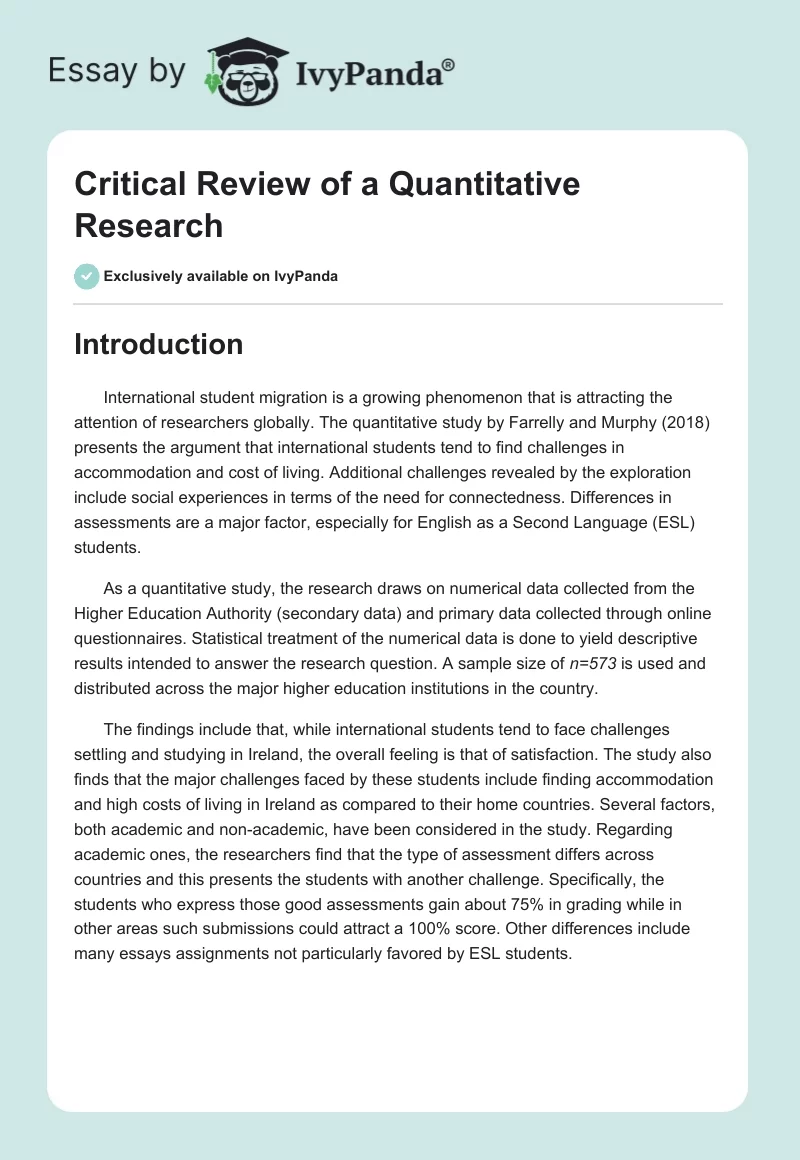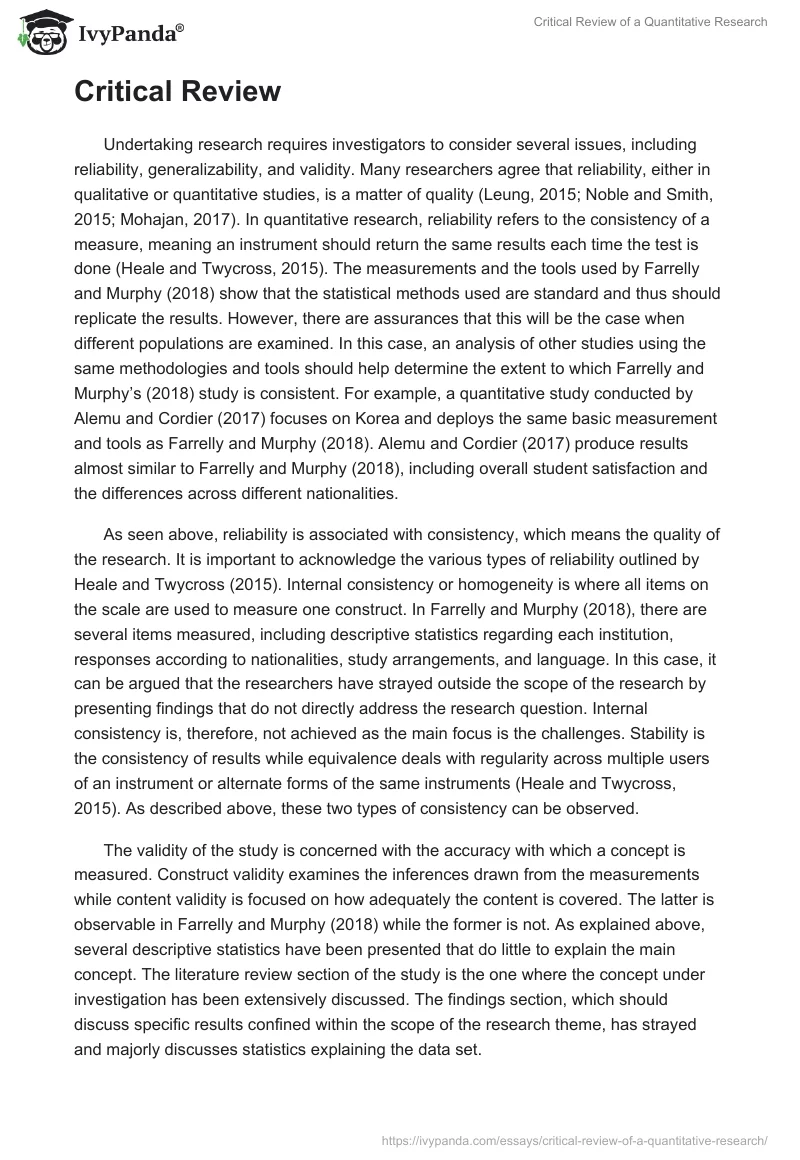Introduction
International student migration is a growing phenomenon that is attracting the attention of researchers globally. The quantitative study by Farrelly and Murphy (2018) presents the argument that international students tend to find challenges in accommodation and cost of living. Additional challenges revealed by the exploration include social experiences in terms of the need for connectedness. Differences in assessments are a major factor, especially for English as a Second Language (ESL) students.
As a quantitative study, the research draws on numerical data collected from the Higher Education Authority (secondary data) and primary data collected through online questionnaires. Statistical treatment of the numerical data is done to yield descriptive results intended to answer the research question. A sample size of n=573 is used and distributed across the major higher education institutions in the country.
The findings include that, while international students tend to face challenges settling and studying in Ireland, the overall feeling is that of satisfaction. The study also finds that the major challenges faced by these students include finding accommodation and high costs of living in Ireland as compared to their home countries. Several factors, both academic and non-academic, have been considered in the study. Regarding academic ones, the researchers find that the type of assessment differs across countries and this presents the students with another challenge. Specifically, the students who express those good assessments gain about 75% in grading while in other areas such submissions could attract a 100% score. Other differences include many essays assignments not particularly favored by ESL students.
Critical Review
Undertaking research requires investigators to consider several issues, including reliability, generalizability, and validity. Many researchers agree that reliability, either in qualitative or quantitative studies, is a matter of quality (Leung, 2015; Noble and Smith, 2015; Mohajan, 2017). In quantitative research, reliability refers to the consistency of a measure, meaning an instrument should return the same results each time the test is done (Heale and Twycross, 2015). The measurements and the tools used by Farrelly and Murphy (2018) show that the statistical methods used are standard and thus should replicate the results. However, there are assurances that this will be the case when different populations are examined. In this case, an analysis of other studies using the same methodologies and tools should help determine the extent to which Farrelly and Murphy’s (2018) study is consistent. For example, a quantitative study conducted by Alemu and Cordier (2017) focuses on Korea and deploys the same basic measurement and tools as Farrelly and Murphy (2018). Alemu and Cordier (2017) produce results almost similar to Farrelly and Murphy (2018), including overall student satisfaction and the differences across different nationalities.
As seen above, reliability is associated with consistency, which means the quality of the research. It is important to acknowledge the various types of reliability outlined by Heale and Twycross (2015). Internal consistency or homogeneity is where all items on the scale are used to measure one construct. In Farrelly and Murphy (2018), there are several items measured, including descriptive statistics regarding each institution, responses according to nationalities, study arrangements, and language. In this case, it can be argued that the researchers have strayed outside the scope of the research by presenting findings that do not directly address the research question. Internal consistency is, therefore, not achieved as the main focus is the challenges. Stability is the consistency of results while equivalence deals with regularity across multiple users of an instrument or alternate forms of the same instruments (Heale and Twycross, 2015). As described above, these two types of consistency can be observed.
The validity of the study is concerned with the accuracy with which a concept is measured. Construct validity examines the inferences drawn from the measurements while content validity is focused on how adequately the content is covered. The latter is observable in Farrelly and Murphy (2018) while the former is not. As explained above, several descriptive statistics have been presented that do little to explain the main concept. The literature review section of the study is the one where the concept under investigation has been extensively discussed. The findings section, which should discuss specific results confined within the scope of the research theme, has strayed and majorly discusses statistics explaining the data set.
The generalizability of quantitative research is critical as the findings should be applicable. Farrelly and Murphy (2018) produce research the findings of which are not only application but also results that have been replicated by both qualitative and quantitative studies. Findings regarding the differences in assessment methods have been produced by studies such as Özoğlu, Gür, and Coşkunet (2015) who cite unfamiliarity with the host country’s education system. Regarding accommodation, the research by Jones (2017) finds that students face challenges in affording houses in host countries. Lastly, the results about the challenges faced and satisfaction of international students in Ireland are similar to the previous works such as O’Reilly, Hickey, and Ryan (2015) and Wu, Garza, and Guzman (2015) among others. Generalization, therefore, is the area where Farrelly and Murphy (2018) have excelled most.
Lastly, the question of the suitability of the research methods used by these researchers can be answered by examining the issues under investigation. It is argued here that the concept studied by Farrelly and Murphy (2018) possesses features that fit qualitative methods better than quantitative. The challenges faced by international students are a social issue that can be examined through the opinions and experiences of the students. These aspects are better understood through qualitative approaches that help in more in-depth analysis. The statistics used by Farrelly and Murphy (2018) do paint a picture of the population sample used. However, challenges and satisfaction are elements that do not need quantification. This criticism does not seek to argue against the use of descriptive statistics because they could be critical in testing hypotheses and characterizing the responses. The survey and the questionnaire tools remain useful for this study and they have been rightly deployed.
Conclusion
Many countries today are experiencing an increasing number of international students, which has led to many studies examining various constructs related to the phenomenon. This critical analysis focuses on Farrelly and Murphy (2018) and their efforts to examine the challenges that international students face in Ireland. Issues of reliability, validity, and generalizability, as well as the efficacy of the research methods, have been critiqued. Besides generalizability, all other aspects have fallen short of expectations in certain ways. For example, the research topic is better suited for a qualitative approach as opposed to a quantitative one. Therefore, the validity and reliability of the study have not been achieved.
Reference List
Alemu, A. and Cordier, J. (2017) ‘Factors influencing international student satisfaction in Korean universities’, International Journal of Educational Development, 57, pp. 54-64.
Farrelly, T. and Murphy, T. (2018) ‘Hindsight is 20/20 vision: what international students wished they had known before coming to live and learn in Ireland’, Journal of International Students, 8(4), pp. 1848-1864.
Heale, R. and Twycross, A. (2015) ‘Validity and reliability in quantitative studies’, Evidence Based Nursing, 18(3), pp. 66-67.
Jones, E. (2017) ‘Problematising and reimagining the notion of ‘international student experience’’, Studies in Higher Education, 42(5), pp. 933-943.
Leung, L. (2015) ‘Validity, reliability, and generalizability in qualitative research’, Journal of Family Medicine and Primary Care, 4(3), pp. 324-327.
Mohajan, H. (2017) ‘Two criteria for good measurements in research validity and reliability’, Annals of Spiru Haret University, 17(3), pp. 58-82.
Noble, H. and Smith, J. (2015) ‘Issues of validity and reliability in qualitative research’, Evidence Based Nursing, 18(2), pp. 34-35.
O’Reilly, A., Hickey, T. and Ryan, D. (2015) ‘The experiences of American international students in a large Irish university’, Journal of International Students, 5(1), pp. 86-98.
Özoğlu, M., Gür, B. and Coşkun, I. (2015) ‘Factors influencing international students’ choice to study in Turkey and challenges they experience in Turkey’, Research in Comparative and International Education, 10(2), pp. 223-237.
Wu, H.-p., Garza, E. and Guzman, N. (2015) ‘International student’s challenge and adjustment to college’, Education Research International, 2015(20), pp. 1-9.


